The Impact of Typhoon “In-Fa” (2021) on Temperature, Salinity, and Chlorophyll-a Concentration in the Upwelling Area of Northwestern East China Sea
Abstract
1. Introduction
2. Materials and Methods
2.1. Study Area
2.2. Typhoon “In-Fa”
2.3. Data
2.4. Method
2.4.1. The Calculation Method of Ekman Pumping Velocity (EPV)
2.4.2. The Calculation Method of Mixed Layer Depth (MLD)
2.4.3. Min–Max Normalization
3. Results
3.1. EPV
3.2. The Change in Seawater Temperature during “In-Fa” Period
3.2.1. SST
3.2.2. Vertical Distribution of Seawater Temperature
3.3. Variation in Sea Surface Salinity (SSS) during “In-Fa” Period
3.4. The Change in Mixed Layer Depth (MLD) during the “In-Fa” Period
3.5. The Change in Chl-a during “In-Fa” Period
3.6. The Change in Precipitation
4. Discussion
5. Conclusions
Author Contributions
Funding
Institutional Review Board Statement
Informed Consent Statement
Data Availability Statement
Conflicts of Interest
References
- Zhou, X.; Yang, X.; Li, Z.; Yu, Y.; Bi, H.; Ma, S.; Li, X. Estimation of tropical cyclone parameters and wind fields from SAR images. Sci. China Earth Sci. 2013, 56, 1977–1987. [Google Scholar] [CrossRef]
- Huo, L.; Guo, P.; Zhang, F. Impact of summer tropical Atlantic SST anomaly on western North Pacific tropical cyclone genesis. Trans. Atmos. Sci. 2016, 39, 55–63. [Google Scholar]
- He, J.; Soden, B.J. Anthropogenic weakening of the tropical circulation: The relative roles of direct CO2 forcing and sea surface temperature change. J. Clim. 2015, 28, 8728–8742. [Google Scholar] [CrossRef]
- Kossin, J.P. Author Correction: A global slowdown of tropical-cyclone translation speed. Nature 2018, 564, E11–E16. [Google Scholar] [CrossRef] [PubMed]
- Wang, Y. Composite of Typhoon-Induced Sea Surface Temperature and Chlorophyll—A Responses in the South China Sea. J. Geophys. Res. Ocean. 2020, 125, e2020JC016243. [Google Scholar] [CrossRef]
- Potter, H.; Drennan, W.M.; Graber, H.C. Upper ocean cooling and air-sea fluxes under typhoons: A case study. J. Geophys. Res. Ocean. 2017, 122, 7237–7252. [Google Scholar] [CrossRef]
- Pan, J.; Sun, Y. Estimate of ocean mixed layer deepening after a typhoon passage over the South China Sea by using satellite data. J. Phys. Oceanogr. 2013, 43, 498–506. [Google Scholar] [CrossRef]
- Pan, S.; Shi, J.; Gao, H.; Xu, Z.; Yan, X. Impacts of Typhoon on Ocean Parimary Production and Nutrients Transport. Period. Ocean. Univ. China 2016, 46, 120–133. [Google Scholar]
- Chen, Y.; Tang, D. Eddy-feature phytoplankton bloom induced by a tropical cyclone in the South China Sea. Int. J. Remote Sens. 2012, 33, 7444–7457. [Google Scholar] [CrossRef]
- Jing, Z.; Qi, Y.; Hua, Z. Numerical study on upwelling and its seasonal variation along Fujian and Zhejiang coast. J. Hohai Univ. (Nat. Sci.) 2007, 165, 464–470. [Google Scholar]
- Hu, M.; Zhao, C. Upwelling in Zhejiang Coastal Areas during Summer Detected by Satellite Observations. Natl. Remote Sens. Bull. 2008, 12, 297–304. [Google Scholar]
- Hu, J.; Wang, X.H. Progress on upwelling studies in the China seas. Rev. Geophys. 2016, 54, 653–673. [Google Scholar] [CrossRef]
- Lu, X.; Yu, H.; Ying, M.; Zhao, B.; Zhang, S.; Lin, L.; Bai, L.; Wan, R. Western North Pacific tropical cyclone database created by the China Meteorological Administration. Adv. Atmos. Sci. 2021, 38, 690–699. [Google Scholar] [CrossRef]
- Narvekar, J.; Roy Chowdhury, R.; Gaonkar, D.; Kumar, P.D.; Prasanna Kumar, S. Observational evidence of stratification control of upwelling and pelagic fishery in the eastern Arabian Sea. Sci. Rep. 2021, 11, 7293. [Google Scholar] [CrossRef] [PubMed]
- Luo, Y.; Shi, J.; Guo, X.; Mao, X.; Yao, P.; Zhao, B.; Chen, L.; Wang, Y. Yearly variations in nutrient supply in the East China Sea due to the Zhejiang coastal upwelling and Kuroshio intrusion. J. Geophys. Res. Ocean. 2023, 128, e2022JC019216. [Google Scholar] [CrossRef]
- McGregor, H.V.; Dima, M.; Fischer, H.W.; Mulitza, S. Rapid 20th-century increase in coastal upwelling off northwest Africa. Science 2007, 315, 637–639. [Google Scholar] [CrossRef]
- Li, X.; Zhang, X.; Fu, D.; Liao, S. Strengthening effect of super typhoon Rammasun (2014) on upwelling and cold eddies in the South China Sea. J. Oceanol. Limnol. 2021, 39, 403–419. [Google Scholar] [CrossRef]
- Ren, Z. Upper Oceanic Response of East China Sea to Typhoon. Master’s Thesis, Zhejiang University, Hangzhou, China, 2019. [Google Scholar]
- Liu, Z.; Xu, J.; Sun, C.; Wu, X. An upper ocean response to Typhoon Bolaven analyzed with Argo profiling floats. Acta Oceanol. Sin. 2014, 33, 90–101. [Google Scholar] [CrossRef]
- Jiang, Q.; Li, W.; Fan, Z.; He, X.; Sun, W.; Chen, S.; Wen, J.; Gao, J.; Wang, J. Evaluation of the ERA5 reanalysis precipitation dataset over Chinese Mainland. J. Hydrol. 2021, 595, 125660. [Google Scholar] [CrossRef]
- Hersbach, H.; Bell, B.; Berrisford, P.; Biavati, G.; Horányi, A.; Muñoz Sabater, J.; Nicolas, J.; Peubey, C.; Radu, R.; Rozum, I. ERA5 hourly data on single levels from 1979 to present. Copernic. Clim. Change Serv. (C3s) Clim. Data Store (Cds) 2018, 10, 10.24381. [Google Scholar]
- Lellouche, J.-M.; Galloudec, O.L.; Regnier, C.; Gennip, S.V.; Chune, S.L.; Levier, B.; Greiner, E.; Drevillon, M.; Szczypta, C. Global Production Centre, GLO_ANALYSISFORECAST_PHY_001_024,Quality Information Document. Available online: https://catalogue.marine.copernicus.eu/documents/QUID/CMEMS-GLO-QUID-001-024.pdf (accessed on 23 July 2023).
- Zhu, J. Dynamic mechanism of the upwelling on the west side of the submerged river valley off the Changjiang mouth in summertime. Chin. Sci. Bull. 2003, 48, 2754–2758. [Google Scholar] [CrossRef]
- Lü, X.; Qiao, F.; Xia, C.; Zhu, J.; Yuan, Y. Upwelling off Yangtze River estuary in summer. J. Geophys. Res. Ocean. 2006, 111, C11S08. [Google Scholar] [CrossRef]
- Yao, J.; Wang, Z. Monthly variation of upwelling area off the Changjiang River Estuary in spring. Mar. Sci. 2017, 41, 1–9. [Google Scholar]
- Chen, L.; Li, F.; Liu, J.; Duan, X.; Xu, G.; Qin, M.; He, X.; Liu, Y. Long-chain alkyl diols as indicators of local riverine input, temperature, and upwelling in a shelf south of the Yangtze River Estuary in the East China Sea. Mar. Geol. 2021, 440, 106573. [Google Scholar] [CrossRef]
- Pan, Y.; Sha, W. Numerical Study on the Summer Coastal Upwelling off Fujian and Zhejiang. Mar. Sci. Bull. 2004, 23, 1–11. [Google Scholar]
- He, Q.; Zhang, C.; Gao, G.; Wei, Y.; An, B. Study on the temporal and spatial characteristics of Zhoushan coastal upwelling and relationship with wind field in Summer period. J. Shanghai Ocean. Univ. 2016, 25, 142–151. [Google Scholar]
- Tang, F.; Chen, F.; Zhu Ge, X.y.; Wu, F.; Yu, L.; Yao, B. Analysis of influence process of Typhoon In-fa (202106) based on satellite remote sensing data. Trans. Atmos. Sci. 2021, 44, 703–716. [Google Scholar]
- Shen, X.; Li, F. Analysis of extreme precipitation in Zhejiang caused by typhoon “In-Fa”. Mar. Forecast. 2022, 39, 37–47. [Google Scholar]
- Bueh, C.; Zhu Ge, A.; Xie, Z.; Gao, Z.; Lin, D. Water Vapor Transportation Features and Key Synoptic-scale Systems of the “7.20” Rainstorm in Henan Province in 2021. Chin. J. Atmos. Sci. 2022, 46, 725–744. [Google Scholar]
- Halpern, D. Offshore Ekman transport and Ekman pumping off Peru during the 1997–1998 El Nino. Geophys. Res. Lett. 2002, 29, 19-1–19-4. [Google Scholar] [CrossRef]
- Wirasatriya, A.; Setiawan, J.D.; Sugianto, D.N.; Rosyadi, I.A.; Haryadi, H.; Winarso, G.; Setiawan, R.Y.; Susanto, R.D. Ekman dynamics variability along the southern coast of Java revealed by satellite data. Int. J. Remote Sens. 2020, 41, 8475–8496. [Google Scholar] [CrossRef]
- Tan, S.; Shi, J.; Wang, G.; Xing, X.; Lü, H. A case study of the westward transport of Chorophyll-a entrained by ocean eddies during a tropical cyclone. Reg. Stud. Mar. Sci. 2022, 52, 102256. [Google Scholar] [CrossRef]
- Kessler, W.S. Mean three-dimensional circulation in the northeast tropical Pacific. J. Phys. Oceanogr. 2002, 32, 2457–2471. [Google Scholar] [CrossRef]
- Greene, C.A.; Blankenship, D.D.; Gwyther, D.E.; Silvano, A.; van Wijk, E. Wind causes Totten Ice Shelf melt and acceleration. Sci. Adv. 2017, 3, e1701681. [Google Scholar] [CrossRef]
- Greene, C.A.; Thirumalai, K.; Kearney, K.A.; Delgado, J.M.; Schwanghart, W.; Wolfenbarger, N.S.; Thyng, K.M.; Gwyther, D.E.; Gardner, A.S.; Blankenship, D.D. The climate data toolbox for MATLAB. Geochem. Geophys. Geosyst. 2019, 20, 3774–3781. [Google Scholar] [CrossRef]
- An, Y.; Zhang, R.; Wang, H.; Chen, J.; Chen, Y. Study on calculation and spatio-temporal variations of global ocean mixed layer depth. Chin. J. Geophys. 2012, 55, 2249–2258. [Google Scholar]
- Patel, R. To Compute Mixed Layer Depth Based on Subjective Method. Available online: https://ww2.mathworks.cn/matlabcentral/fileexchange/53370-to-compute-mixed-layer-depth-based-on-subjective-method (accessed on 12 October 2022).
- Zhao, H.; Tang, D.; Wang, Y. Comparison of phytoplankton blooms triggered by two typhoons with different intensities and translation speeds in the South China Sea. Mar. Ecol. Prog. Ser. 2008, 365, 57–65. [Google Scholar] [CrossRef]
- Xiu, P.; Dai, M.; Chai, F.; Zhou, K.; Zeng, L.; Du, C. On contributions by wind-induced mixing and eddy pumping to interannual chlorophyll variability during different ENSO phases in the northern South China Sea. Limnol. Oceanogr. 2019, 64, 503–514. [Google Scholar] [CrossRef]
- Wu, L.; Ling, Z. Analysis of sea surface salinity response to typhoon in the Northwest Pacific based on Argo data. J. Mar. Sci. 2015, 33, 1–6. [Google Scholar]
- Wang, X.; Wang, X.; Chu, P.C. Air-sea interactions during rapid intensification of typhoon Fengshen (2008). Deep. Sea Res. Part I Oceanogr. Res. Pap. 2018, 140, 63–77. [Google Scholar] [CrossRef]
- Liu, G. Spatial and Temporal Variability of Chlorophyll-a Patterns and Its Mechanisms off the Yangtze River Estuary. Master’s Thesis, East China Normal University, Shanghai, China, 2014. [Google Scholar]
- Ding, C. The Formation Mechanism and Prediction Application of Tropical Cyclone Accumulated Rainfall Structure Over China. Ph.D. Thesis, Nanjing University of Information Science & Technology, Nanjing, China, 2022. [Google Scholar]
- Yi, W.; Yu, H.; Wei, H.; Nie, Y.; Wen, X. Analysis of flood process and high water levels in upper stream Huangpu River during typhoon In-fa. Express Water Resour. Hydropower Inf. 2023, 44, 18–22. [Google Scholar]
- Wada, A.; Niino, H.; Nakano, H. Roles of vertical turbulent mixing in the ocean response to Typhoon Rex (1998). J. Oceanogr. 2009, 65, 373–396. [Google Scholar] [CrossRef]
- Sanford, T.B.; Price, J.F.; Girton, J.B. Upper-ocean response to Hurricane Frances (2004) observed by profiling EM-APEX floats. J. Phys. Oceanogr. 2011, 41, 1041–1056. [Google Scholar] [CrossRef]
- Pan, J.; Huang, L.; Devlin, A.T.; Lin, H. Quantification of typhoon-induced phytoplankton blooms using satellite multi-sensor data. Remote Sens. 2018, 10, 318. [Google Scholar] [CrossRef]
- Suzuki, S.-i.; Niino, H.; Kimura, R. The mechanism of upper-oceanic vertical motions forced by a moving typhoon. Fluid Dyn. Res. 2011, 43, 025504. [Google Scholar] [CrossRef]
- Cheung, H.-F.; Pan, J.; Gu, Y.; Wang, Z. Remote-sensing observation of ocean responses to Typhoon Lupit in the northwest Pacific. Int. J. Remote Sens. 2013, 34, 1478–1491. [Google Scholar] [CrossRef]
- Glenn, S.; Miles, T.; Seroka, G.; Xu, Y.; Forney, R.; Yu, F.; Roarty, H.; Schofield, O.; Kohut, J. Stratified coastal ocean interactions with tropical cyclones. Nat. Commun. 2016, 7, 10887. [Google Scholar] [CrossRef] [PubMed]
- Kim, T.; Choo, S.-H.; Moon, J.-H.; Chang, P.-H. Contribution of tropical cyclones to abnormal sea surface temperature warming in the Yellow Sea in December 2004. Dyn. Atmos. Ocean. 2017, 80, 97–109. [Google Scholar] [CrossRef]
- Prasad, T.; Hogan, P.J. Upper-ocean response to Hurricane Ivan in a 1/25 nested Gulf of Mexico HYCOM. J. Geophys. Res. Ocean. 2007, 112, C04013. [Google Scholar] [CrossRef]
- Zhang, H.; Chen, D.; Zhou, L.; Liu, X.; Ding, T.; Zhou, B. Upper ocean response to typhoon Kalmaegi (2014). J. Geophys. Res. Ocean. 2016, 121, 6520–6535. [Google Scholar] [CrossRef]
- Subrahmanyam, M.; Shengyan, Y.; Raju, P.V.S. Typhoon Haikui induced sea surface temperature cooling and rainfall influence over Zhejiang coastal waters. Atmósfera 2021, 34, 385–394. [Google Scholar]
- Wu, R.; Li, C. Upper ocean response to the passage of two sequential typhoons. Deep. Sea Res. Part I Oceanogr. Res. Pap. 2018, 132, 68–79. [Google Scholar] [CrossRef]
- Fu, D.; Luan, H.; Pan, D.; Zhang, Y.; Wang, L.a.; Liu, D.; Ding, Y.; Li, X. Impact of two typhoons on the marine environment in the Yellow Sea and East China Sea. Chin. J. Oceanol. Limnol. 2016, 34, 871–884. [Google Scholar] [CrossRef]
- Guan, S.; Zhao, W.; Sun, L.; Zhou, C.; Liu, Z.; Hong, X.; Zhang, Y.; Tian, J.; Hou, Y. Tropical cyclone-induced sea surface cooling over the Yellow Sea and Bohai Sea in the 2019 Pacific typhoon season. J. Mar. Syst. 2021, 217, 103509. [Google Scholar] [CrossRef]
- Fu, D.; Pan, D.; Wang, D.; Zhang, Y.; Ding, Y.; Liu, D. The analysis of phytoplankton blooms off the Yangtze River Estuary in the spring of 2007. Aquat. Ecosyst. Health Manag. 2014, 17, 221–232. [Google Scholar] [CrossRef]
- Zhao, H.; Tang, D.; Wang, D. Phytoplankton blooms near the Pearl River estuary induced by Typhoon Nuri. J. Geophys. Res. Ocean. 2009, 114, C12027. [Google Scholar] [CrossRef]
- Gabric, A.; Parslow, J. Effect of physical factors on the vertical distribution of phytoplankton in eutrophic coastal waters. Mar. Freshw. Res. 1989, 40, 559–569. [Google Scholar] [CrossRef]
- Behrenfeld, M.J.; O’Malley, R.T.; Siegel, D.A.; McClain, C.R.; Sarmiento, J.L.; Feldman, G.C.; Milligan, A.J.; Falkowski, P.G.; Letelier, R.M.; Boss, E.S. Climate-driven trends in contemporary ocean productivity. Nature 2006, 444, 752–755. [Google Scholar] [CrossRef] [PubMed]
- Chen, G.; Xiu, P.; Chai, F. Physical and biological controls on the summer chlorophyll bloom to the east of Vietnam. J. Oceanogr. 2014, 70, 323–328. [Google Scholar] [CrossRef]
- Diez-Minguito, M.S.; Huib, E. Relationships Between Chlorophyll-a and Suspended Sediment Concentration in a High-Nutrient Load Estuary: An Observational and Idealized Modeling Approach. J. Geophys. Res. Ocean. 2020, 125, e2019JC015188. [Google Scholar] [CrossRef]
- YongQiang, C.; DanLing, T. Remote sensing analysis of impact of typhoon on environment in the sea area south of Hainan Island. Procedia Environ. Sci. 2011, 10, 1621–1629. [Google Scholar] [CrossRef]
- Cui, X.-p.; Li, X. Effects of sea surface temperature and its diurnal variation on diurnal variation of rainfall: A partitioning analysis based on surface rainfall budget. J. Trop. Meteorol. 2012, 18, 89–97. [Google Scholar]
- Subrahmanyam, M. Impact of typhoon on the north-west Pacific sea surface temperature: A case study of Typhoon Kaemi (2006). Nat. Hazards 2015, 78, 569–582. [Google Scholar] [CrossRef]
- Perigaud, C.; McCreary, J.P., Jr.; Zhang, K.Q. Impact of interannual rainfall anomalies on Indian Ocean salinity and temperature variability. J. Geophys. Res. Ocean. 2003, 108, 3319. [Google Scholar] [CrossRef]
- Bond, N.A.; Cronin, M.F.; Sabine, C.; Kawai, Y.; Ichikawa, H.; Freitag, P.; Ronnholm, K. Upper ocean response to Typhoon Choi-Wan as measured by the Kuroshio Extension Observatory mooring. J. Geophys. Res. Ocean. 2011, 116, C02031. [Google Scholar] [CrossRef]
- Kil, B.; Burrage, D.; Wesson, J.; Howden, S. Sea surface signature of tropical cyclones using microwave remote sensing. In Proceedings of the Ocean Sensing and Monitoring V, Baltimore, MD, USA, 3 June 2013; pp. 370–384. [Google Scholar]
- Liu, G.; Li, X.; Wang, J.; Kou, Y.; Wang, X. Research on the statistical characteristics of typhoon frequency. Ocean Eng. 2020, 209, 107489. [Google Scholar] [CrossRef]
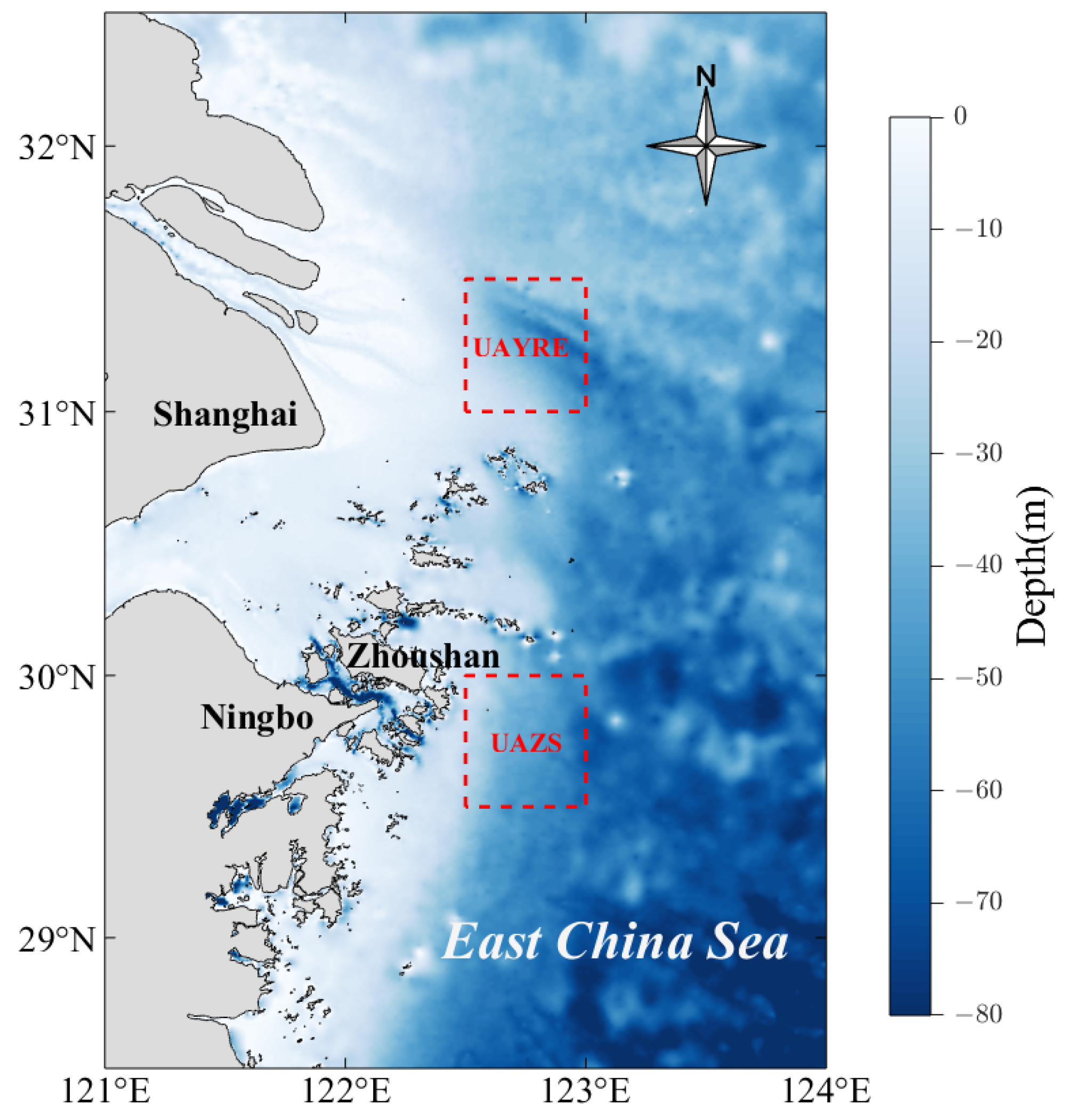


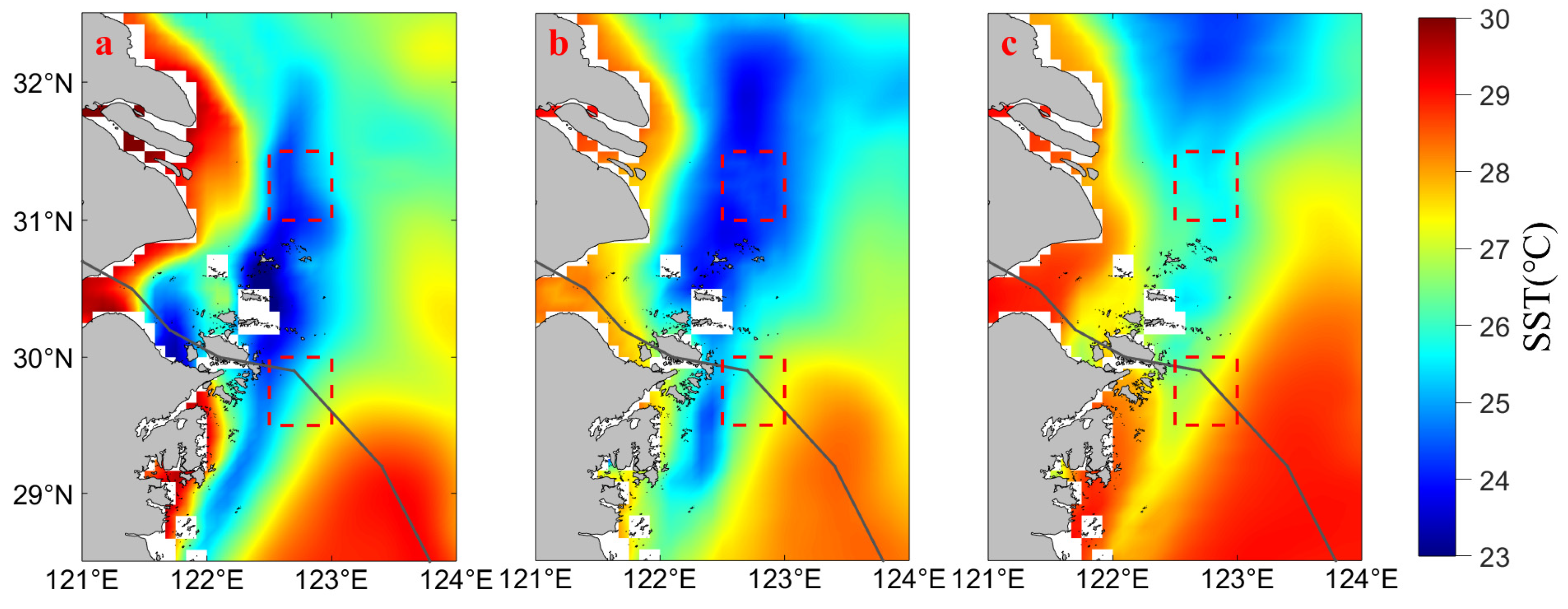

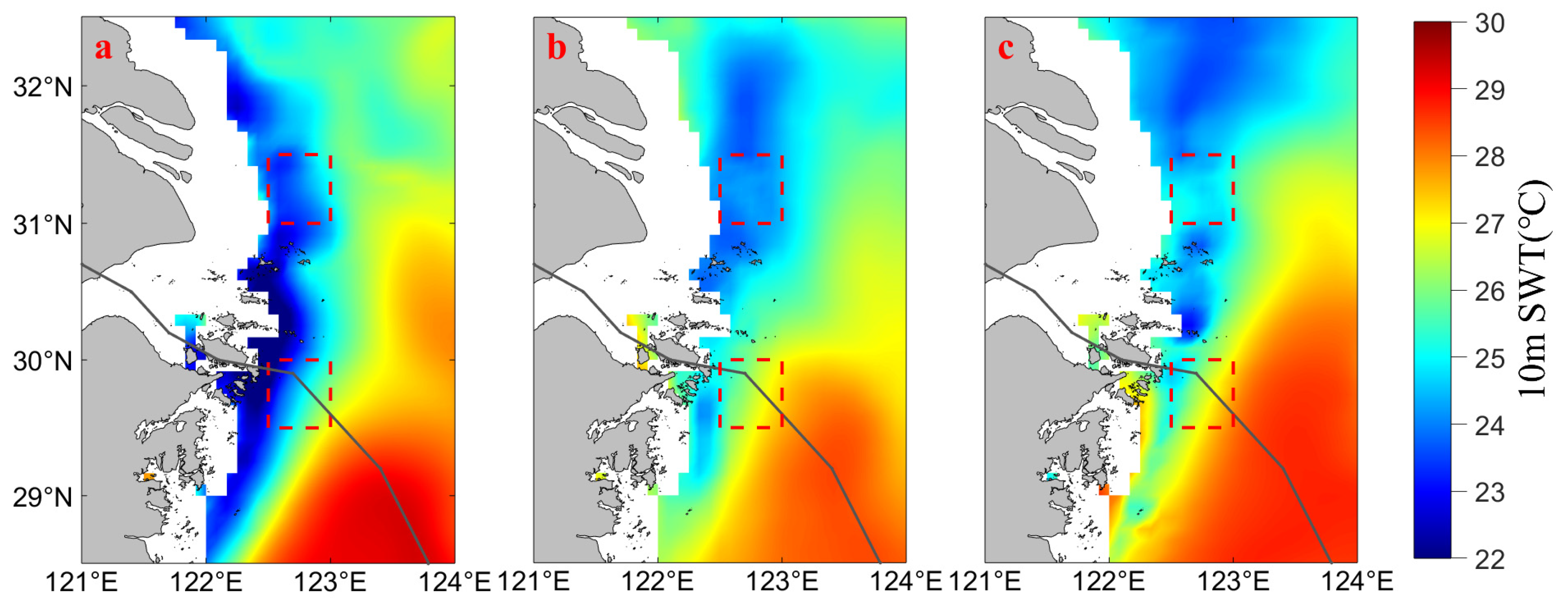
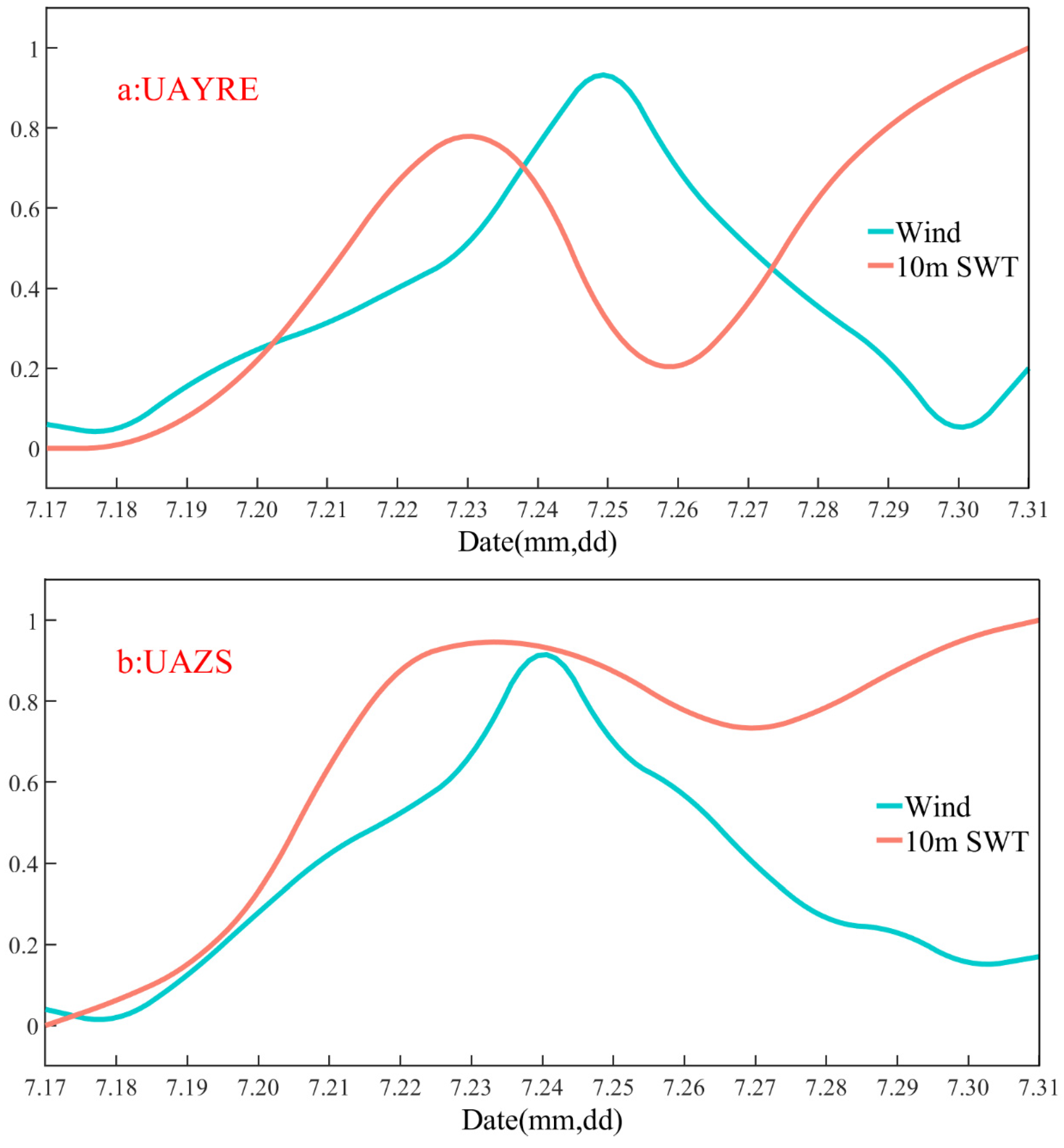


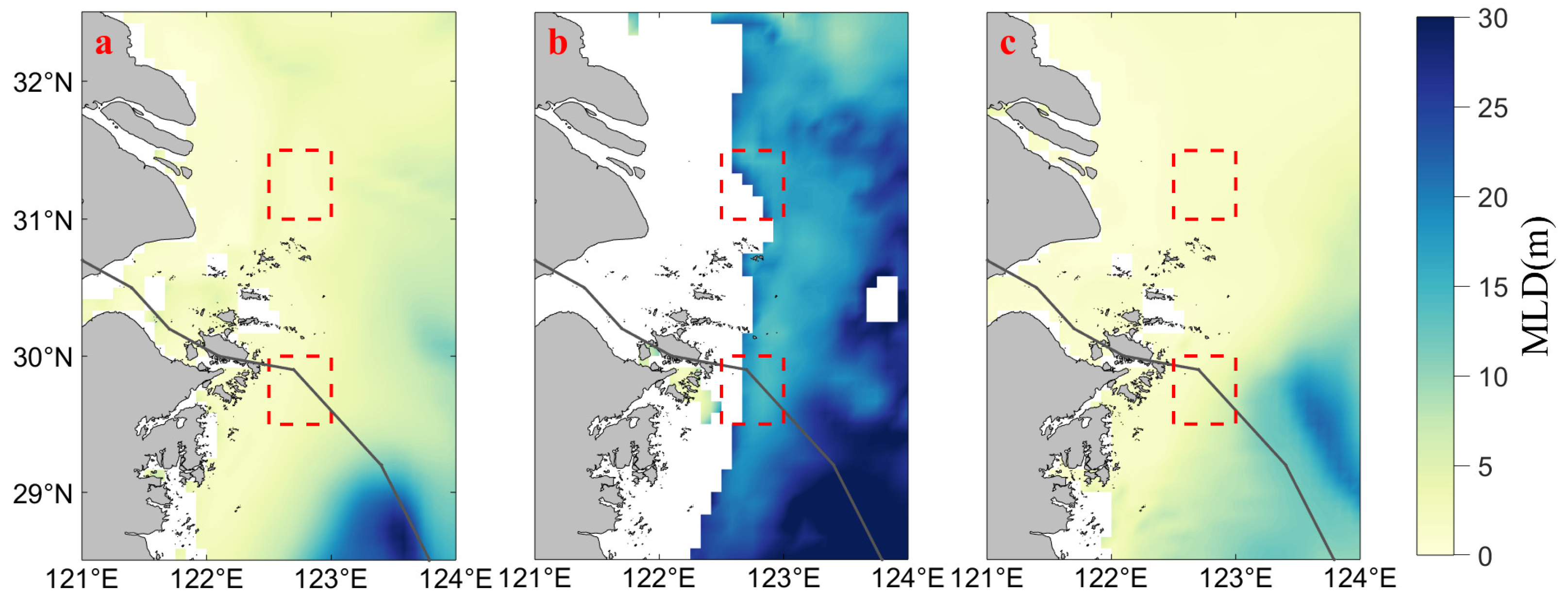
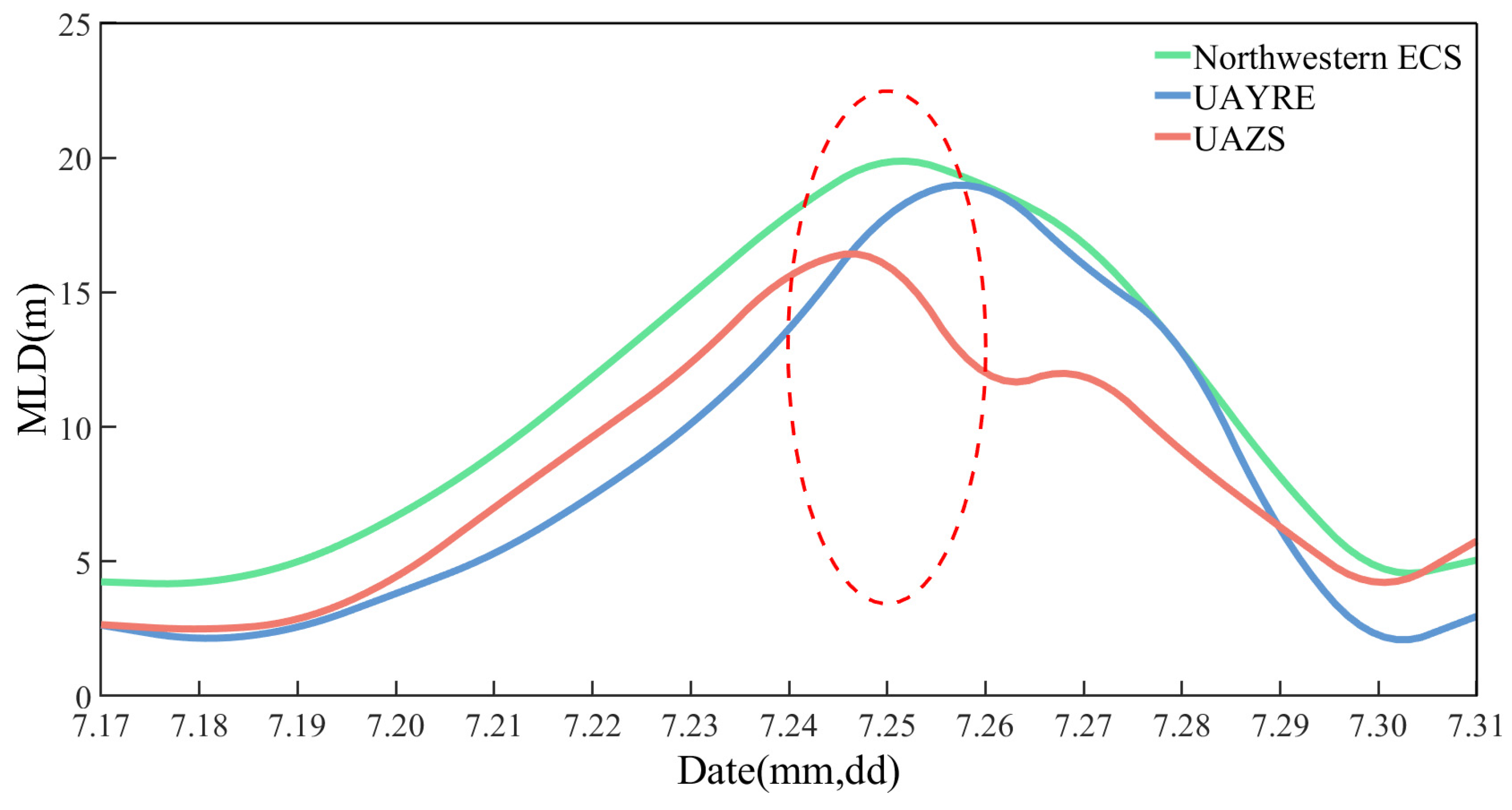
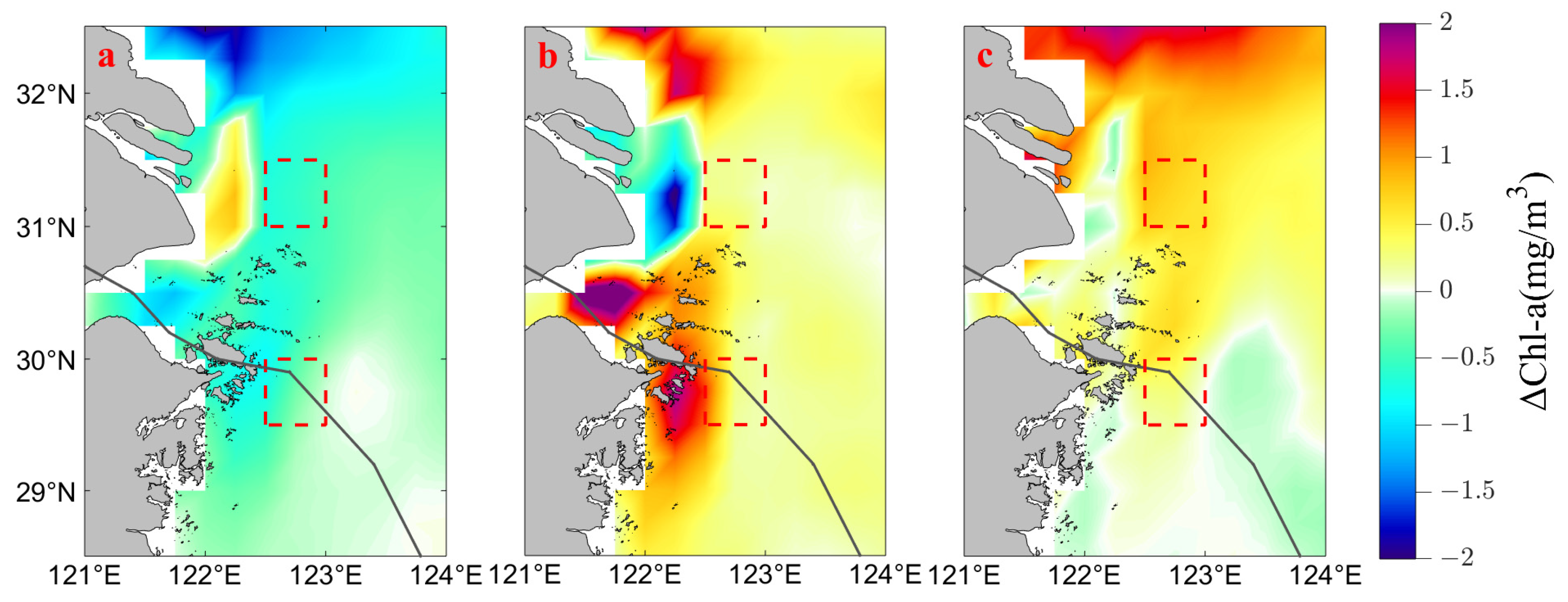
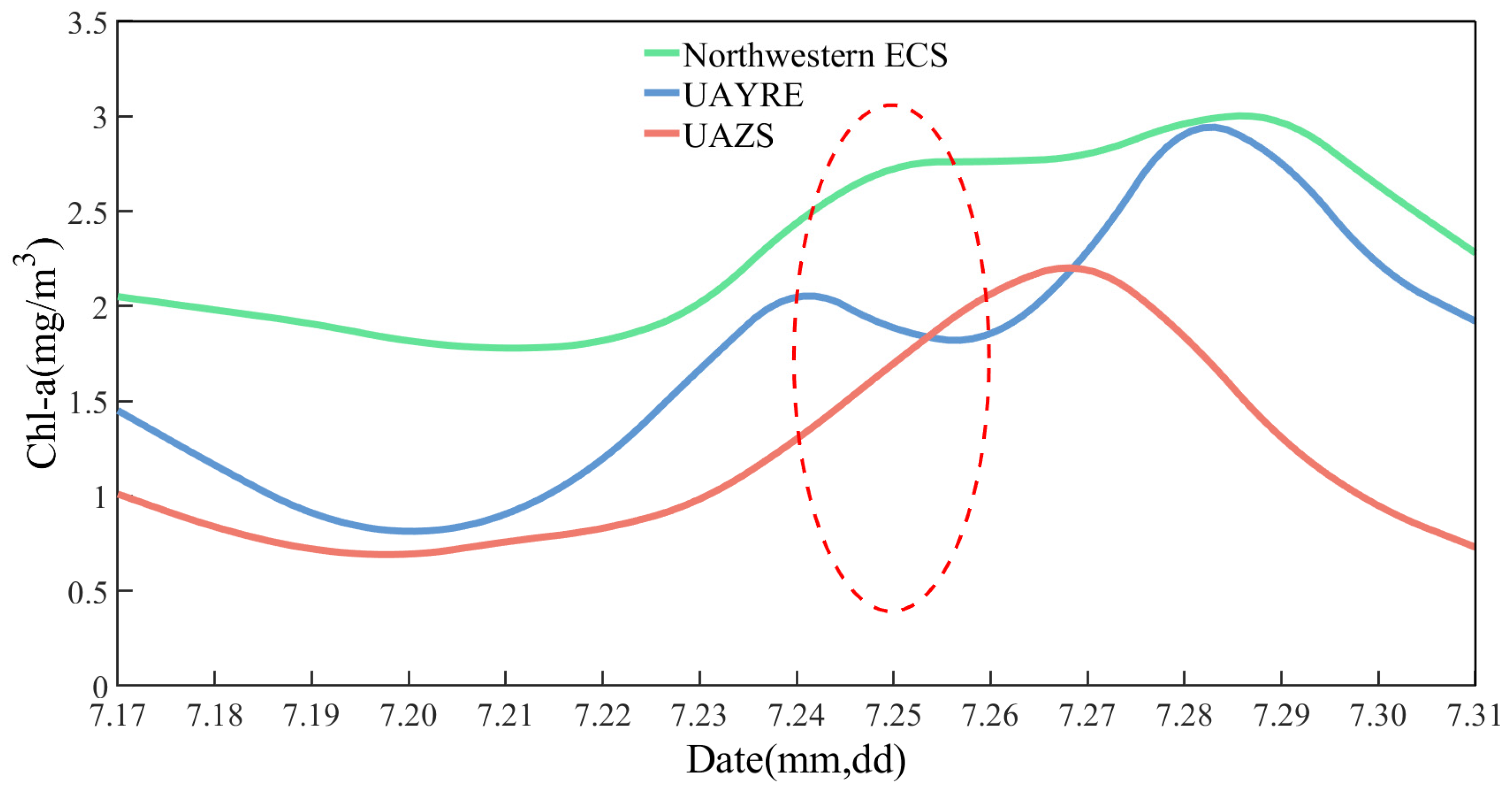

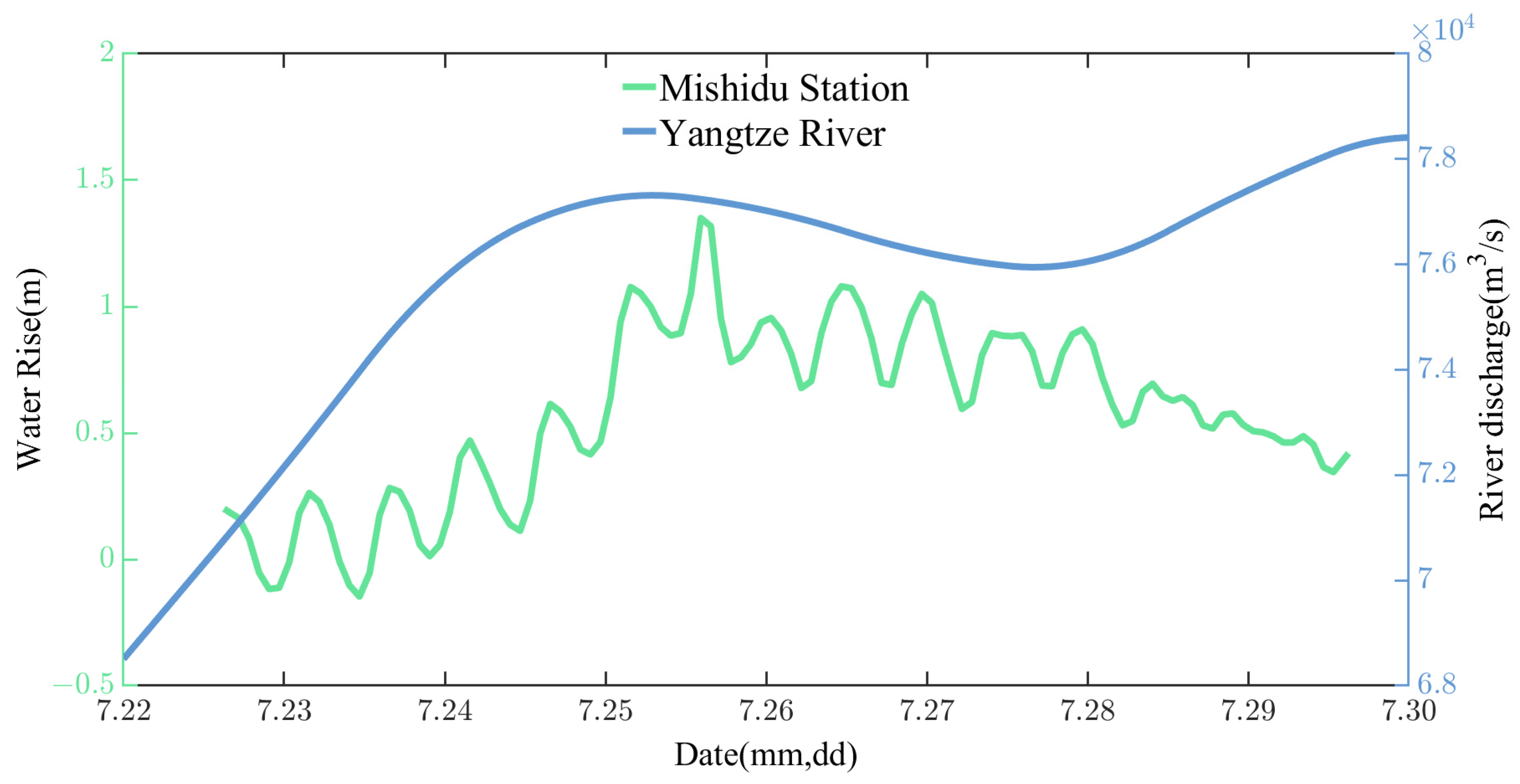
| Time (UTC) | Long (°E) | Lat (°N) | Pressure (hPa) | (m/s) | Intensity Level |
|---|---|---|---|---|---|
| 7/21/00 | 127.9 | 24.1 | 955 | 42 | Severe Typhoon |
| 7/21/12 | 126.6 | 24.0 | 955 | 42 | Severe Typhoon |
| 7/22/00 | 126.0 | 23.4 | 955 | 42 | Severe Typhoon |
| 7/22/12 | 125.8 | 23.6 | 955 | 42 | Severe Typhoon |
| 7/23/00 | 125.4 | 24.2 | 965 | 38 | Typhoon |
| 7/23/12 | 125.0 | 24.8 | 965 | 38 | Typhoon |
| 7/24/00 | 124.6 | 26.4 | 965 | 38 | Typhoon |
| 7/24/12 | 124.1 | 27.9 | 965 | 38 | Typhoon |
| 7/24/18 | 123.7 | 28.6 | 968 | 35 | Typhoon |
| 7/25/00 | 123.0 | 29.7 | 968 | 35 | Typhoon |
| 7/25/03 | 122.7 | 29.9 | 968 | 35 | Typhoon |
| 7/25/06 | 122.2 | 30.0 | 970 | 33 | Typhoon |
| 7/25/09 | 122.1 | 30.0 | 972 | 30 | Severe tropical storm |
| 7/25/12 | 121.9 | 30.1 | 972 | 30 | Severe tropical storm |
| 7/25/18 | 121.5 | 30.4 | 975 | 28 | Severe tropical storm |
| 7/26/00 | 121.2 | 30.6 | 978 | 25 | Severe tropical storm |
| 7/26/06 | 120.9 | 30.8 | 978 | 25 | Severe tropical storm |
| 7/26/09 | 120.7 | 30.9 | 980 | 23 | Tropical storm |
| 7/27/00 | 119.4 | 31.3 | 985 | 20 | Tropical storm |
| Data Name | Spatial Resolution | Temporal Resolution | Time Range | Source |
|---|---|---|---|---|
| Wind Precipitation | 0.1° × 0.1° | 1 h | 17 July 2021 to 31 July 2021 | ECMWF |
| River discharge | 0.05° × 0.05° | 1 day | 22 July 2021 to 30 July 2021 | |
| Seawater temperature | 0.083° × 0.083° | 1 day | 17 July 2021 to 31 July 2021 | Copernicus |
| Seawater salinity | ||||
| Chlorophyll-a concentration |
Disclaimer/Publisher’s Note: The statements, opinions and data contained in all publications are solely those of the individual author(s) and contributor(s) and not of MDPI and/or the editor(s). MDPI and/or the editor(s) disclaim responsibility for any injury to people or property resulting from any ideas, methods, instructions or products referred to in the content. |
© 2023 by the authors. Licensee MDPI, Basel, Switzerland. This article is an open access article distributed under the terms and conditions of the Creative Commons Attribution (CC BY) license (https://creativecommons.org/licenses/by/4.0/).
Share and Cite
Che, Y.; Guo, B.; Mantravadi, V.S.; Wang, J.; Ji, Z. The Impact of Typhoon “In-Fa” (2021) on Temperature, Salinity, and Chlorophyll-a Concentration in the Upwelling Area of Northwestern East China Sea. Atmosphere 2023, 14, 1226. https://doi.org/10.3390/atmos14081226
Che Y, Guo B, Mantravadi VS, Wang J, Ji Z. The Impact of Typhoon “In-Fa” (2021) on Temperature, Salinity, and Chlorophyll-a Concentration in the Upwelling Area of Northwestern East China Sea. Atmosphere. 2023; 14(8):1226. https://doi.org/10.3390/atmos14081226
Chicago/Turabian StyleChe, Yingliang, Biyun Guo, Venkata Subrahmanyam Mantravadi, Jushang Wang, and Zhaokang Ji. 2023. "The Impact of Typhoon “In-Fa” (2021) on Temperature, Salinity, and Chlorophyll-a Concentration in the Upwelling Area of Northwestern East China Sea" Atmosphere 14, no. 8: 1226. https://doi.org/10.3390/atmos14081226
APA StyleChe, Y., Guo, B., Mantravadi, V. S., Wang, J., & Ji, Z. (2023). The Impact of Typhoon “In-Fa” (2021) on Temperature, Salinity, and Chlorophyll-a Concentration in the Upwelling Area of Northwestern East China Sea. Atmosphere, 14(8), 1226. https://doi.org/10.3390/atmos14081226







